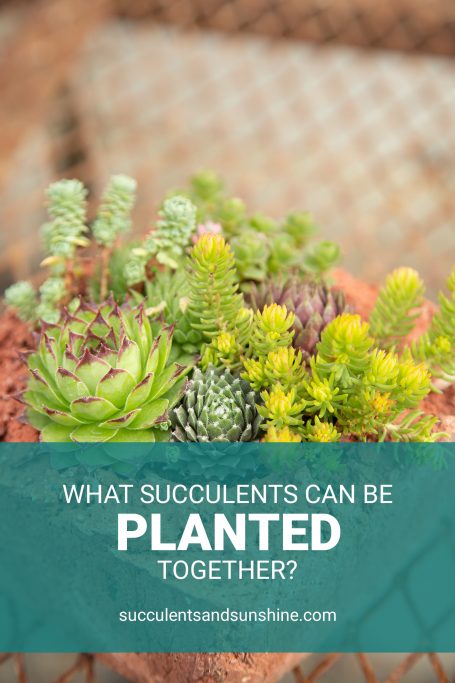What succulents can be planted together?
Succulents have a lot of characteristics that tie them together, like storing water in their leaves or stem for a not-so rainy day.
While you can combine just about any succulents together, some will be much easier to maintain in the same arrangement than others.
Succulents and Sunshine is reader supported. We may earn a commission, if you purchase through links on our site, such as Mountain Crest Gardens, Amazon, or Etsy. We only promote products we use and trust.

Below I'll mention a number of characteristics to look for when combining succulents. Many of these characteristics are outlined on our individual succulent pages and are included for 100 succulents in my book.
You can also watch my video where I go over 3 different succulent arrangements and why they work:
Light Requirements
While most succulents will do well with morning sun and bright shade in the afternoon, not all will do well in full shade or indoors. There are also succulents that prefer full sun all day.
If you were to combine succulents that have different light requirements, you may not have any problems initially, but over time you’ll start to see stretching from some or sunburn on others.
Water Needs
Most succulents are very drought tolerant but some succulents will survive much longer than others without water. Usually thicker leaved succulents need less frequent water while thinner leaved succulents need more frequent.
A few succulents that prefer more water are Portulacaria afra variegata, Rhipsalis cereuscula, and Crassula arborescens undulatifolia "Ripple Jade".
On the opposite end, most cacti as well as Echeverias will need more time between watering.
You can still combine succulents with different water needs, but you’ll likely find that you have to “spot water” or give those thinner leaved succulents a direct dose of water that doesn’t get to the thicker plants. This can be done with a syringe or the water bottle from my favorite succulent tool kit.
Color
This won't effect their care requirements, or how they grow, it's definitely a fun part of arranging succulents. It’s pretty hard to go wrong with combining succulents, but using traditional color palettes in your arrangements will make them look really great.
For example, use complementary colors (colors opposite each other on the color wheel) such as reds and greens, or (one of my personal favorites) blues and oranges, looks really great.
I tend to plant succulents in analogous color schemes (colors next to each other on a color wheel)… such as blues, greens and purples. You can also do monochromatic combinations, such as all greens but some light, some dark and some in between!
Also keep in mind that the succulents aren't the only part of the color palette.
The pot you use plays a big part as well! You may have a red pot and pair it with green succulents to use that complementary color scheme. Or maybe your succulents are mostly blues and greens and you use a purple pot to tie it all together.
While these are all good guidelines for combining succulents, you really can combine just about anything that looks good to you.
It may take a little work to keep it looking its best, but it's absolutely doable!